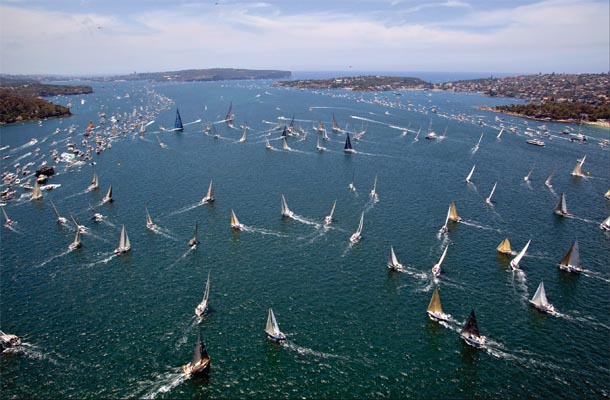Intermediate sailing is aimed at anyone who already has the basics and would like to progress a bit further and maybe do a bit of racing. A little knowledge on sailing terms as well as interesting sailing tactics also come in handy. Strategic awareness when sailing and how to handle your boat effectively can make a big difference. A clear head, calm and decisive action and a few pointers below can give you that edge over other sailors. With a little bit of knowledge and a little bit more observation there’s no doubt on how far and fast one can go! So here’s a list of useful questions and tips to polish up your sailing lingo and take your sailing skills to the next level.
What is a burgee?
Small pennant used to determine wind direction. The burgee is placed atop the mast to determine wind direction. It has a metal rod through it and works like a wind vane.
What is the most efficient use of the sails when sailing downwind?
Wing and wing. In sailing wing and wing, the main sail is let all the way out, and the jib is allowed to catch the wind on the other side of the boat. This allows for optimum wind on both sails, and the vessel is pushed forward.
A tack is when the boat turns its bow through the wind, and the weather side changes. What is the maneuver called, when the boat is turned and the wind crosses the stern?
Jibe & Gybe. The Jibe is not used as often as the tack because it can be a violent move. It is mainly used in racing or to evade an obstacle. In high winds, it can be tough and should only be attempted by proficient sailors.

What is the sail used in addition to the main and jib, to add speed to a boat sailing downwind?
Spinnaker. The spinnaker sail is mainly used in racing situations, and is often brighly colored.
How are sailboats moved left or right?
Rudder. The rudder is attached to a tiller, or can be controlled by a wheel on larger vessels. The boat must be moving forward with speed to be effectively steered. This is called steerageway.
A sail works just like an airplane wing?
The same principles apply except that a sail is mounted vertically. Different pressures create lift, and work to propel the boat forward.
What is the fastest point of sailing?
Reaching. Reaching is when the wind is at a right-angle to the direction of travel. The sails are let about half-way out and the vessel can reach optimum speed. Running is when the wind is directly behind, and the boat is being pushed along.
The closest a boat can normally sail is at a 45 degree angle into the wind?
This is the closest angle of attack in order to sail into the wind. The boat must be zig-zaged (tacked) from left to right to reach a destination from where the wind is blowing. Larger and older sailing ships had even less of an angle. This must have been tiring when exploring new waters.
A boat has a port(left) and starboard(right) side. In describing a boats side relative to the wind, which terms are used?
Windward and Leeward. The weather is the side on to which the wind is blowing, while the lee is the opposite or sheltered side of the boat. These are interchangeable according to direction.

What are the two types of rigging found on a sailing boat?
Running and Standing. Running rigging controls the movement of the sails. Halyards raise and lower the sails. Sheets are ropes attached to the sails, used to adjust them according to wind and course desired. Standing rigging is used to support the mast, and on small boats consists of two shrouds and a forestay. The shrouds give sideways support, and the forestay gives front and back support, by running from the bow to the top of the mast. Larger boats require more supports to secure the mast.
You have arrived at shore, what should you do now?
Put the boat on its trolley and lower the sails.
You are racing down wind and are ahead of everyone in your class, when a gust of wind causes you to capsize. You have to right yourself by swimming round to the centreboard, and what must you do?
All of these (Communicate with your crew, (if you have one), Hold onto the mainsheet as a safety line, Make sure the centreboard is fully down). You should do all these things, though the crew (if you have one)can check the centre board. Also the crew should check the mainsheet is free.
You have started moving again when you approach the second buoy, how do you round the buoy?
Gybe. Most race courses have gybes.
The wind dies down and you are slowing. Should you heel the boat towards you?
No. In light winds heeling the boat away from you will fill the sails.
You have rounded the buoy and are 90 degrees from the wind. Are you sailing on a broad reach?
No. You are on a beam reach. This is when the sails are half out and the centre board is half down.
You set off and tack towards the first buoy. What do you do when you get there?
Broaden up. It is best whenever rounding a buoy to stay as close as possible to it (without hitting into it).
You are approaching the start line, you know all the other boats are faster than you and you want to have right of way. What do you do?
Go on a starboard tack. Starboard tack boats have right of way.
You leave the shore on a port tack avoiding the no-sail zone. You could go on a close-haul, but the wind is blowing on shore at an angle so you can what?
Close reach. A close reach is about 65 degrees from the wind.
You are launching from a beach, and the wind is blowing on to the land, this means the shore is a what?
Lee shore. A weather shore where the wind is coming offshore.
The magnetic error caused by iron and steel objects such as the engine, which form integral parts of a vessel is called ______ ?
Deviation. Variation is the effect of the Earth’s magnetic field, and varies throughout the world. Leeway is the sideways drift of a sailing vessel caused by the wind; the further forward the wind direction, the greater the leeway. Compass error is simply the combination of variation and deviation – which can sometimes cancel each other out!

When a sailing vessel turns away from the wind direction, it is ________ ?
Gybing. Tacking is turning into and through the wind. Running is sailing with the wind behind the vessel. “Heaving to” is a method of temporarily stopping a vessel with the sails still fully set.
North, South, East, and West cardinal navigation buoys are what colours?
Black and yellow. Cardinal buoys are very important in navigation as they are positioned to indicate underwater hazards. North cardinals are black on top and yellow on bottom. South cardinals are yellow on top and black at bottom. East cardinals are black at top and bottom and yellow in centre. West cardinals are yellow at top and bottom and black in centre.
When a vessel is under sail the wind felt by those on board is known as the _________ ?
Apparent wind. The apparent wind is due to the vessel’s motion through the water, and is only the same as the true wind when the vessel is stationary.
A type of flag flown by foreign vessels visiting another country, while they are in the territorial waters of that country, is known as a ___________ ?
Courtesy flag. Courtesy flags are an old and well established maritime tradition. Failure to fly a courtesy flag can be taken as an insult in some countries, resulting in serious trouble! The courtesy flag is usually flown above any other flags.
The fitting on a fore and aft rigged vessel which attaches a boom to a mast is called a ______ ?
Gooseneck. It allows the boom – which is the long spar supporting the bottom of the sail – to swing easily from side to side.
A rope used to hoist or lower a sail is called a ___________ ?
Halyard. Halyard comes from “Haul Yard” which refers to the wood spars supporting the sails of Square Riggers.
The mount used to house the steering compass is called a ________ ?
Binnacle. Halyards are used to hoist and lower sails. A Spinnaker is a large light wind and usually colourful headsail. A windlass is a type of winch. On smaller vessels the steering compass is normally fixed to the cockpit bulkhead rather than on a separate mount.
A Sailing vessel having two masts, the ‘aft’, i.e. rear mast, being taller than the front (for’ard) mast is called a ______________ ?
Schooner. Other vessels such as ketches, yawls and brigs also have 2 masts, but do not meet this precise description of the schooner.

Which colour indicates Starboard?
Green. Starboard is of course “right”, so think of “green for go is all right”!
Apart from a harbour, port means what?
Left. “No PORT wine LEFT in the bottle” is the easy way to remember this.
What are “warps & springs” used for?
Tying up a vessel to a jetty or harbour. Warps are used to keep the vessel close to the shore. Springs are used to prevent it moving backwards or forwards.
This article was compiled from: http://www.funtrivia.com/en/Sports/Sailing-5927.html
